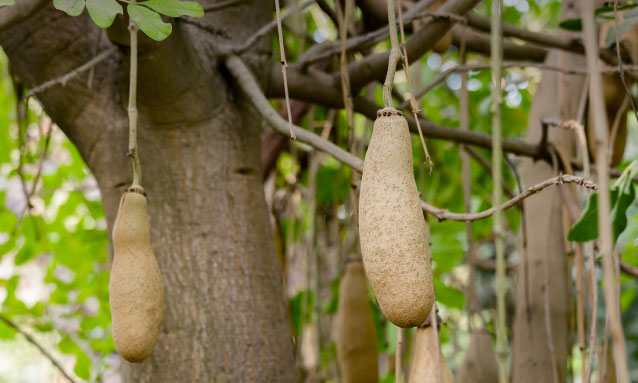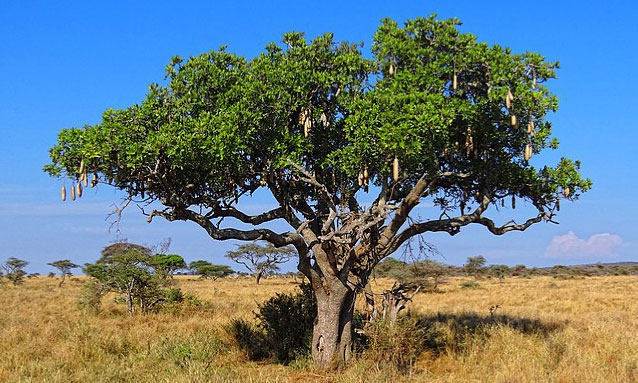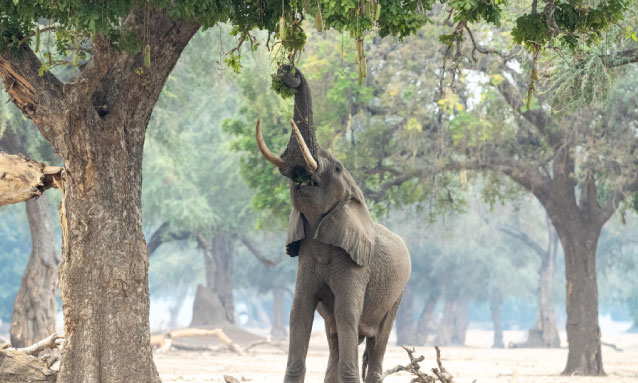
The sausage tree, or moporota to use its Setswana name, is shrouded in an age-old myth that it has the power to enhance libido and sexual prowess in both humans and animals. Then, of course, there’s the belief that moporota is the miraculous answer to impotence. According to legend, this ‘unsung’ champion of herbal remedies can also add inches AND girth to the appendages of the unfortunate men who are cursed with possessing a pecker so small it leaves them open to unfair ridicule from the fairer sex. Whether or not they have seen it, most Batswana will have heard the countless myths relating to moporota; there is no end to the wild claims!
I remember many moons ago there was a story about a man who desperately sought to enhance his ridiculously tiny phallus and set off for Kasane to see a witch doctor about his problem. There, the man allegedly met with a traditional doctor who specialised in male sexual health, including adding inches and width where required. Long story short, the man’s prayers were answered, and he was very happy with how everything panned out. Naively, he thought he could outsmart the traditional doctor and skipped town without settling his bill. Needless to say, the traditional doctor was not best pleased and cast a spell on him. He allegedly made it so that the man’s member would not stop growing, turning his life into a living hell. Legend said it grew so long and big, he had to wind it around his waist and could not put it to use! Desperate attempts to right his wrongs with the traditional doctor fell on deaf ears. As is always the case with these types of stories, we never did find out what became of the man beyond the fact that his sex life was left in tatters.
A wise old man’s perspective
A few years ago, Mmegi newspaper interviewed an elderly man, Maratla Mahale, to get to the bottom of the age-old sausage tree claims. The 90-year-old elder confirmed the claims were not a myth. He said the practice did exist, maybe even in modern times. He said the practice was carried out by traditional doctors using various methods. Some traditional doctors used the sausage fruit while others used a branch from the tree to coax out the trouser snake.
According to Mahale, traditional doctors made it so that the manhood would grow in tandem with the parts of the tree used. He said the man would then return to the traditional doctor once he was happy with the size, at which point the doctor would cut the branch or fruit which was used to perform the spell. This, in turn, would stop the Johnson from growing out of control. He said this explains why there are many amusing stories told of men who got a little more than they bargained for when they forgot the exact location of the tree used or the traditional doctor who cast the spell died or left the village.
Mahale said since Batswana are traditionally too conservative to openly discuss issues around sex, the practice might have been a closely guarded secret available only on request. However, he said he wasn’t sure if the practice still existed as most traditional medicine skills died with the older generations.
Mmegi quoted an excerpt from a book titled ‘Among the animals of Africa’, by Bernard Grzimek saying the fruits from the sausage tree are a delicacy for several African wild animals, particularly elephants. In the book, the author says the sausage fruits are not only fodder for jumbos but have also been found to heighten libido and promote virility. Perhaps this explains the ever booming elephant population in southern Africa!
Interestingly, it appears claims of the sausage tree’s powers are widespread across the southern African countries, including neighbouring Zambia, Namibia and Zimbabwe! Traditional Zambian farmers have been known to try the trick for agricultural purposes. Based on the phallic shape of the sausage tree, the farmers made weird and wonderful potions out of the plant and spread them on maize fields, believing that the cobs would grow big like the sausage fruits! In some African societies, the tree is reportedly worshipped as a holy tree around which important spiritual functions are hosted. Way back in time, if a loved one died while they were far away from home, the Ndebele would bury a sausage fruit in place of the corpse to allow the family to find closure.
The tree is found mainly on river banks, wet areas along streams and the floodplains of Nigeria, Kenya, Cameroon, Senegal and Guinea. It can also be found in open woodland from KwaZulu-Natal to Tanzania, Chad, Eritrea, South Africa and Namibia.
In the Okavango Delta, some of the traditional Mekoro (dugout canoes) used to take adoring tourists on a unique game viewing excursions over the scenic Okavango waters are carved from the sausage tree. Elsewhere in Africa, the tree is used to tackled rheumatism, snake bites, evil spirits, syphilis as well as brew alcohol. The sausage tree has reportedly been exported to Asia and Europe, where it takes place of pride in many a garden.
Whether you choose to believe these wild stories or not, there’s no denying that the sausage tree is one of Botswana and many African countries’ most special trees.

The sausage tree – location, description
The tree comes from a family of trees scientifically known as the genus kigelia Africana. It is the only species from this tree family found in Africa. The tree is found in tropical Africa from Senegal, Eritrea, Chad and southern African countries, including Botswana. It can grow up to 20 m tall and commonly grows near water, which is why in Botswana, it’s mainly found in the Okavango Delta and Chobe areas. It derives the ‘sausage tree’ moniker from its sausage-like fruits, which can grow up to 100 cm long and weigh up to 10 kg!
It is grown as an ornamental plant in tropical regions for its beautiful flowers and unusual fruit. It has pretty flowers that hang down from the branches on long and flexible stems. The flowers are bell-shaped, orange to maroon or purplish green and about 10 cm (4 inches) wide.
In Botswana it most often concentrated at or near riverbanks, being one of the dominant species occurring on the islands in the Okavango Delta as well as flood plains of the Chobe District. It generally flowers from August to October, while it bears fruit from December to June. The fruit is very heavy, and as such, camping under a Sausage tree is not recommended.
Sausage tree fruit
The fruit is a woody berry that measures about 30 to 99 cm and 18 cm broad and weighs anything from 5 to 10 kg. The pulp of the fruit is fibrous and contains many seeds.

How various countries use the sausage tree
Traditional healers generally use all parts of the tree to treat skin ailments, boils, fungal infections, eczema, psoriasis and ringworm, circulatory disorders, digestion, tapeworm, dysentery, diabetes, malaria, haemorrhaging, toothache, sex health and pneumonia.
- In Botswana, the wood is used to make dugout canoes, paddles, planks and fencing material.
- In West Africa, the fruit is made into a drink for young children in Southern Nigeria. The leaves are used to treat stomach and kidney ailments as well as dysentery and wounds in various parts of West Africa.
- In Malawi, the dried root is used to treat uterus cancer and gastrointestinal cancer.
- In Tanzania, the bark is used to treat swollen and tender breasts.
- In Cote d’Ivoire, the fruit decoction is used to treat water retention in the legs and elephantiasis.
- In Central Africa, the raw fruit is used to treat syphilis and as a dressing for rheumatism.
- In Zimbabwe, a decoction made from the bark is used to gargle to treat toothache.
- In Central Kenya, the dried fruit is used to make an alcoholic beverage called Muratina, a firm favourite at cultural events.
This versatile miracle plant has more uses!
Kigelia is also used in various skin care products. The fruit can be boiled to produce a red dye while the roots are reportedly used to produce a yellow dye. It is also used to make wooden boxes, drums, stools, yokes, tool handles, mortars and large bowls for watering cattle. Because the sausage tree commonly grows along riverbanks, it helps prevent erosion and shores up the banks.
Side effects
The unripe fruit is highly poisonous if taken orally and can cause blisters. Although the fruit is used to make traditional remedies and may contain anti-bacterial properties, you should NOT try to use it at home as it can be poisonous, especially when fresh – unless you know what you are doing.
Sources: http://www.healthbenefitstimes.com/know-about-sausage-tree/ BWGovernment Facebook page / http://www.mmegi.bw/index.php?sid=6&aid=754&dir=2013/february/Monday4


I really need that miraculous medicinal tree
I have this wonder tree.
Reach me @+264857544623/
kasangaj0711@gmail.com
I really need sausage tree, I’m told it does health wonders to human generally.
I really need this medicine which I have heard that it does health wonders.
I really need this medicine.
I really need this medicine
edwardmunyoro91@gmail.com